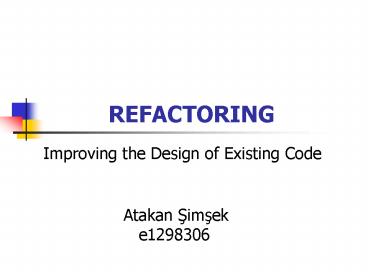REFACTORING - PowerPoint PPT Presentation
1 / 28
Title:
REFACTORING
Description:
Improving the design of existing code. without changing the code's ... Code complexity tends to increase rapidly over time(Patching new functionalities) ... – PowerPoint PPT presentation
Number of Views:50
Avg rating:3.0/5.0
Title: REFACTORING
1
REFACTORING
- Improving the Design of Existing Code
Atakan Simsek e1298306
2
Outline
- Definition of Refactoring
- WhyWhen Refactor?
- Refactoring Steps
- Refactoring Examples
- Bad Smells
- Definiton
- Solution
- Conclusion
3
Definition
- Refactoring (noun)
- Improving the design of existing code
- without changing the code's observable
- behavior.
4
Some Definitions
- Fowler a change made to the internal structure
of software to make it - easier to understand
- cheaper to modify
- without changing its observable behavior
- Beck Improving the design after it has been
written.
5
Why Refactor ?
- Easier to understand
- It becomes easy for others to understand.
- To find the bugs
- Finding the Bugs in the program.
6
- To reduce
- Software maintenance costs
- To faciliate
- Future changes
7
- To program faster
- Code complexity tends to increase rapidly over
time(Patching new functionalities) - Development slows down
- Refactoring helps keeping complexity under
control - Development proceed
- more rapidly
8
When to Refactor ?
- When you add a function
- Helps you to understand the code when modifying.
- Sometimes the existing design does not allow you
to easily add the feature. - When you need to fix a bug
- If it is difficult to trace an error
- Code was not clear enough for you to see the
bug in the first place.
9
- When you do a Code Review
- When you detect a bad smell (an indication
that something is wrong) in the code
10
Refactor? or NOT?
- Code does not work NOT
- Code has some bugs REFACTOR
- Very Close to Deadline NOT
- There are bad smells REFACTOR
11
Bad Smells
12
Where Can We Use?
Producer Side
Consumer Side
COSE
13
Conditions of Refactoring
- Refactoring implies working
- incrementally
- Making changes to the program in
- small steps
- In between run the unit tests
- regularly
- If you make a mistake it's easy to back out.
14
Steps to Refactoring
- Analysis, helps to identify the code
- Identify problems in code by review using bad
smells of code - Introduce a refactoring
- Test
15
Refactorings
- Add Parameter
- Change Association
- Reference to value
- Value to reference
- Collapse hierarchy
- Consolidate conditionals
- Procedures to objects
- Decompose conditional
- Encapsulate collection
- Encapsulate downcast
- Encapsulate field
- Extract class
- Extract Interface
- Extract method
- Extract subclass
- Extract superclass
- Form template method
- Hide delegate
- Hide method
- Inline class
- Inline temp
- Introduce assertion
- Introduce explain variable
- Introduce foreign method
16
Refactoring examples
- Change Association
- Encapsulate Field
- Replace Number with Constants
- Compose Conditions
- Extract Class
17
Bi-directional Association to Unidirectional
- We have a two-way association but one class
- no longer needs features from the other.
18
Self Encapsulate Field
- Create getting and setting methods for the field
and use only those to access the field.
private int _low, _high boolean includes (int
arg) return arg gt _low arg lt _high
private int _low, _high boolean includes (int
arg) return arg gt getLow() arg lt
getHigh() int getLow() return _low int
getHigh() return _high
19
Replace Magic Number with Symbolic Constant
- Create a constant, name it after the meaning, and
replace the number with it.
double potentialEnergy(double mass, double
height) return mass 9.81 height
double potentialEnergy(double mass, double
height) return mass GRAVITATIONAL_CONSTANT
height static final double
GRAVITATIONAL_CONSTANT 9.81
20
Consolidate conditionals
- When we have a complicated conditional
(if-then-else) statement.
double disabilityAmount() if (_seniority lt
2) return 0 if (_monthsDisabled gt 12)
return 0 if (_isPartTime) return 0 //
compute the disability amount
double disabilityAmount() if
(isNotEligableForDisability()) return
0 // compute the disability amount
21
Extract Class
- You have one class doing work that should be done
by two. - Create a new class and move the relevant fields
22
Bad Smells in Code
- Parallel Interface Hierarchies
- Lazy Class
- Speculative Generality
- Temporary Field
- Message Chains
- Middle Man
- Inappropriate Intimacy
- Incomplete Library Class
- Data Class
- Refused Bequest
- Duplicated Code
- Long Method
- Large Class
- Long Parameter List
- Divergent Change
- Shotgun Surgery
- Feature Envy
- Data Clumps
- Primitive Obsession
- Switch Statements
23
Few solutions to Bad Smells
- Duplicated Code
- If you see the same code structure in more than
one place
24
- Duplicated Code(cont.)
- Bugs copied as well
- Increase maintenance cost
- solution perform EXTRACT METHOD and invoke the
code from both places.
25
- Long Parameter List
- An object invokes a method, then passes the
result as a parameter for a method. - solution
- Use REPLACE PARAMETER with METHOD
- Remove the parameter and let the receiver invoke
the same method with sender.
26
- Long Method
- The longer a procedure is the more difficult it
is to understand. - solution perform EXTRACT METHOD
27
Conclusion
- Refactoring is useful to any program that has
at least one of the following shortcomings - Programs that are hard to read
- Programs that have bad smells
- Programs that require additional behavior
28
References
- More Information can be found
- http//www.refactoring.com/
- http//www.refactoring.be/
- Refactoring Improving the Design of Existing
Code - By Martin Fowler

